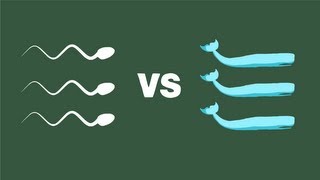(单词翻译:单击)
In 1977, the physicist Edward Purcell calculated that if you push a bacteria and then let go,
1977年,物理学家爱德华·珀塞尔计算出,如果你推动一个细菌然后任它而去,
it will stop in about a millionth of a second.
它将在大概一百万分之一秒内停止运动。
In that time, it will have traveled less than the width of a single atom.
在这样短的时间内,它运动的距离小于一个原子的宽度。
The same holds true for a sperm and many other microbes.
这种情况适用于精子和其它很多微生物。
It all has to do with being really small.
它们都必须非常小。
Microscopic creatures inhabit a world alien to us, where making it through an inch of water is an incredible endeavor.
微生物栖生在一个完全不同于我们的世界,对它们来说,渡过一英尺的水都将极其困难。
But why does size matter so much for a swimmer?
不过为何大小对于“游泳者”如此重要呢?
What makes the world of a sperm so fundamentally different from that of a sperm whale?
是什么使得精子的世界与抹香鲸的世界有着完全不同呢?
To find out, we need to dive into the physics of fluids.
为了找到答案,我们需要潜入流体的物理世界。
Here's a way to think about it. Imagine you are swimming in a pool.
试着从这个角度来想一下。想象你在一个游泳池里游泳。
It's you and a whole bunch of water molecules.
有你和一大堆的水分子。
Water molecules outnumber you a thousand trillion trillion to one.
水分子的数量级是你的千万亿万亿倍。
So, pushing past them with your gigantic body is easy, but if you were really small,
所以,你庞大的身躯很容易在它们中间前行,但是如果你非常小的话,
say you were about the size of a water molecule, all of a sudden, it's like you're swimming in a pool of people.
小到和水分子差不多的话,突然之间,就变成你在一游泳池的人中间游泳。
Rather than simply swishing by all the teeny, tiny molecules,
不同于轻松地在一堆小小的分子中挥动游弋,
now every single water molecule is like another person you have to push past to get anywhere.
现在每个水分子都像另一个人,你必须推动划过他们才能到达别的地方。
In 1883, the physicist Osborne Reynolds figured out that there is one simple number that can predict how a fluid will behave.
1883年,物理学家奥斯本·雷诺计算出一个简易的常数,可以预知流体的表现能力。
It's called the Reynolds number, and it depends on simple properties like the size of the swimmer,
这个常数叫做“雷诺数”,它适用于简单的个体,比如“游泳者”的大小、
its speed, the density of the fluid, and the stickiness, or the viscosity, of the fluid.
游的速度、流体的密度以及流体的黏度或稠度。
What this means is that creatures of very different sizes inhabit vastly different worlds.
这意味着大小不同的生物生活在完全不同的世界。
For example, because of its huge size, a sperm whale inhabits the large Reynolds number world.
比如,由于极其巨大,抹香鲸生活在大雷诺数世界。
If it flaps its tail once, it can coast ahead for an incredible distance.
它拍打一下尾巴,可以向前游很远。
Meanwhile, sperm live in a low Reynolds number world.
而精子则生活在低雷诺数世界。
If a sperm were to stop flapping its tail, it wouldn't even coast past a single atom.
如果精子停止摇动尾巴,它向前的距离不会超过一个原子。
To imagine what it would feel like to be a sperm, you need to bring yourself down to its Reynolds number.
想象一下变成精子是什么样的,你需要把自己放到它所在的雷诺数中。
Picture yourself in a tub of molasses with your arms moving about as slow as the minute hand of a clock,
想象自己在一罐蜜糖中,你挥动手臂的速度和分针一样慢,
and you'd have a pretty good idea of what a sperm is up against.
你就能明白精子对抗的是什么。
So, how do microbes manage to get anywhere?
那么,微生物是如何移动的呢?

Well, many don't bother swimming at all. They just let the food drift to them.
许多微生物根本不考虑游泳。它们让食物带着前行。
This is somewhat like a lazy cow that waits for the grass under its mouth to grow back.
就像一头懒牛等着它嘴下的那块草长回来。
But many microbes do swim, and this is where those incredible adaptations come in.
但有些微生物会游泳,它们有惊人的适应性。
One trick they can use is to deform the shape of their paddle.
其中一个方式就是改变纤毛的形状。
By cleverly flexing their paddle to create more drag on the power stroke than on the recovery stroke,
灵巧地弯曲纤毛可以使动力大于阻力,
single-celled organisms like paramecia manage to inch their way through the crowd of water molecules.
单细胞生物,比如草履虫,就可以在水分子中前行。
But there's an even more ingenious solution arrived at by bacteria and sperm.
还有更绝的,就是细菌和精子的方法。
Instead of wagging their paddles back and forth, they wind them like a cork screw.
它们并不把前后摆动纤毛,而是旋转着,就像螺旋拔塞。
Just as a cork screw on a wine bottle converts winding motion into forward motion,
同酒瓶中的螺旋拔塞将旋转运动转化成向前运动一样,
these tiny creatures spin their helical tails to push themselves forward in a world where water feels as thick as cork.
这些微小的生物旋转着螺旋状的尾巴,使自己向前,它们世界中的水同瓶塞一样硬。
Other strategies are even stranger. Some bacteria take Batman's approach.
另一种办法更加奇怪。一些病毒选择了蝙蝠侠的方法。
They use grappling hooks to pull themselves along.
它们用抓钩将自己拉起。
They can even use this grappling hook like a sling shot and fling themselves forward.
它们甚至还能像弹弓一样将自己弹过去。
Others use chemical engineering.
另一些则使用化学方法。
H. pylori lives only in the slimy, acidic mucus inside our stomachs.
幽门螺旋杆菌只在胃中的酸性粘液中生活。
It releases a chemical that thins out the surrounding mucus, allowing it to glide through slime.
它们释放一种化学物质,使周围的粘液变薄,从而划过粘液。
Maybe it's no surprise that these guys are also responsible for stomach ulcers.
这些家伙也要对胃溃疡负责,这并不奇怪。
So, when you look really closely at our bodies and the world around us,
所以,当你近距离观察我们的身体和这个世界,
you can see all sorts of tiny creatures finding clever ways to get around in a sticky situation.
你可以看到各种各样的小生物用聪明的方法应对棘手的情况。
Without these adaptations, bacteria would never find their hosts,
如果不去适应,细菌就找不到寄主,
and sperms would never make it to their eggs, which means you would never get stomach ulcers,
精子也遇不到卵子,这意味着你也不会得胃溃疡,
but you would also never be born in the first place.
但你在一开始也压根就不会出生。


